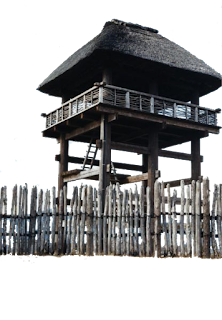Monday, April 10, 2023
Prehistory of Japan
The very first human habitation in the Japanese archipelago has been traced to Paleolithic period around 35,000 BC.
During much of this period, Japan was connected to the Asian continent by land bridges due to lower sea levels, via Sakhalin Island in the north and via the Ryukyu Islands and Taiwan in the south. Also, the Korea Strait was quite narrow at the Last Glacial Maximum from 25,000 to 20,000 years BC.
Radiocarbon dating has shown that the earliest fossils in Japan date back to around 32,000–27,000 years ago; for example in the case of Yamashita Cave c. 32,000 BC, in Sakitari Cave c. 30,000 BC, in Shiraho Saonetabaru Cave c. 27,000 BC among others.
The study of the Japanese Paleolithic period is characterized by a high level of stratigraphic information due to the volcanic nature of the archipelago: large eruptions tend to cover the islands with levels of Volcanic ash, which are easily datable and can be found throughout the country as a reference.
The Japanese Paleolithic is unique in that it incorporates one of the earliest known sets of ground stone and polished stone tools in the world. The tools, which have been dated to around 30,000 BC, are a technology associated in the rest of the world with the beginning of the Neolithic around 10,000 BC. It is not known why such tools were created so early in Japan.
The Paleolithic populations of Japan, as well as the later Jōmon populations, appear to relate to an ancient Paleo-Asian group which occupied large parts of Asia before the expansion of the populations characteristic of today's people of China, Korea, and Japan.
Skeletal characteristics point to many similarities with other aboriginal people of the Asian continent. Dental structures belong to the Sundadont group, mainly distributed in ancient populations of South-East Asia.
The period of Japanese prehistory that spans from about 12,000 BC to about 1,000 BC is known as The Jōmon period. In this time Japan was inhabited by a hunter-gatherer culture that reached a considerable degree of sedentism and cultural complexity. The name Jōmon is the Japanese translation for "cord-marked" pottery, which was typical for that time. The pottery style characteristic of the first phases of Jōmon culture was decorated by impressing cords into the surface of wet clay and is generally accepted to be among the oldest in East Asia and the world.
The earliest pottery in Japan was made at or before the start of the Incipient Jōmon period. Small fragments, dated to 14,500 BC, were found at the Odai Yamamoto I site in 1998.
The Early and Middle Jōmon periods saw an explosion in population, as indicated by the number of settlements from this period. This occurred during the Holocene climatic optimum (between 4000 and 2000 BC), when the local climate became more humid.
The Jōmon period was rich in tools and jewellery made from bone, stone, shell and antler; pottery figurines and vessels; and lacquerware. There is evidence that the Jōmon people built ships out of big trees and used them for fishing and traveling. There is no agreement if they used sails or paddles.
The degree to which horticulture or small-scale agriculture was practiced by Jōmon people is debated. The hunter-gatherer conceptualization of the Jōmon period culture is part of scientific romanticized narratives. There is evidence to suggest that arboriculture was practiced, which place them somewhere in between hunting-gathering and agriculture.
Some elements of modern Japanese culture may had come from Jomon groups. Among these elements are the precursors to Shinto, some marriage customs, some architectural styles, and possibly some technological developments such as lacquerware, laminated yumi, metalworking, and glass making.
At the end of the Jōmon period the local population declined sharply. Scientists suggest that this was possibly caused because of food shortages and other environmental problems.
Between 1,000 and 800 BC the Yayoi people, an ancient ethnic group, migrated to the Japanese archipelago from the Asian continent. They interacted and mixed with the Jōmon people to form the modern Japanese people.
The period between 1,000 BC and 300 AD is known as The Yayoi period, and it covers the Neolithic and the Bronze Age in Japan. Distinguishing characteristics of the Yayoi period include the appearance of new Yayoi pottery styles and the start of an intensive rice agriculture in paddy fields. A hierarchical social class structure dates from this period and has its origin in China. Techniques in metallurgy based on the use of bronze and iron were also introduced from China over Korea to Japan in this period.
They wove textiles, lived in permanent farming villages, and constructed buildings with wood and stone. They also accumulated wealth through land ownership and the storage of grain. Such factors promoted the development of distinct social classes.
The earliest written records about people in Japan are from Chinese sources from this period. Wo, the pronunciation of an early Chinese name for Japan, was mentioned in 57 AD. Early Chinese historians described Wo as a land of hundreds of scattered tribal communities.
The population of Japan began to increase rapidly, reaching between 1.5 to 4.5 million by the end of the Yayoi period. The Yayoi tribes gradually coalesced into a number of kingdoms.
During the subsequent Kofun period, most of Japan gradually unified under a single kingdom. The symbol of the growing power of Japan's new leaders was the kofun burial mounds they constructed from around 250 AD. The center of the unified state was Yamato in the Kinai region of central Japan. The rulers of the Yamato state were a hereditary line of Emperors who still reign as the world's longest dynasty. Starting with this period begins the recorded history of Japan.




